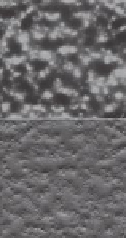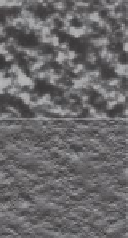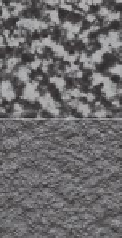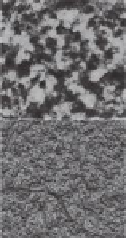Biomedical Engineering Reference
In-Depth Information
0 Day
7 Days
14 Days
30 Days
62 Days
20
µ
m
×
20
µ
m
FIGURE 14.3
Height (top) and phase (bottom) 20 micron AFM images of epoxy/5% silane-
treated nanosilica composite surface before and after UV irradiation for different times, show-
ing a gradual accumulation of silica nanoparticles on the composite surface (at 18.5 MJ/m²/day).
have formed a dense entangled layer on the composite surface, which is clearly seen
in the high magnification image (inset). Similar surface evolution of MWCNTs was
observed for epoxy nanocomposite containing 3.5% mass fraction of MWCNTs in
the NIST SPHERE (Petersen et al. 2013) and for PU with 3% MWCNTs under ISO
4892 irradiation (Wohlleben et al. 2013). From the microscopic and spectroscopic
results, these studies suggested that the increased MWCNT concentration at the
nanocomposite surface with UV irradiation was a result of the matrix photodegrada-
tion. As the epoxy matrix degraded and was removed, MWCNTs were increasingly
exposed on the surface and formed a dense entangled structure with no evidence
of release, even after long exposure time. The thickness of the MWCNT layer on
the composite surface was approximately 400 nm (by cross-section SEM imaging)
after 43 days of exposure and remained essentially unchanged between 45-day and
9-month exposures, suggesting that MWCNT layer on the composite surface prob-
ably shielded the UV radiation from attacking the epoxy matrix underneath.
Metal oxide nanoparticles, such as alumina (Al
2
O
3
) and titania (TiO
2
), and nonmetal
oxides, such as silicon dioxide (SiO
2
), are currently the largest volume nanofillers used
for polymer nanocomposites (Future Markets 2012). The metal oxide fillers serve many
functions in the plastics and coatings industries. TiO
2
and ZnO are traditionally used
as pigments to enhance the appearance and improve the durability of polymeric prod-
ucts. However, due to their ability to absorb broadband UV, these materials at nano-
size have been exploited in applications such as self-cleaning coatings, UV-resistant
coatings, and sunscreens. These nanofillers are also used for modifying optical proper-
ties, for example, increasing the refractive index of coatings. The degradation of sev-
eral polymer/metal oxide nanoparticle composites irradiated with UV radiation has
been investigated. For example, a photo-oxidation study of a PU coating containing
different amounts of two types of TiO
2
nanoparticles showed that both photocataly-
sis of PU/anatase TiO
2
nanocomposite and photostability of PU/rutile TiO
2
nanocom-
posite increased with an increase in the TiO
2
nanoparticle content (Chen et al. 2007).





Search WWH ::

Custom Search